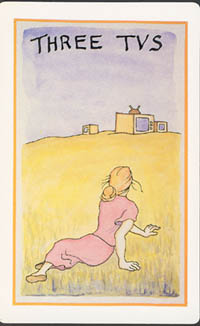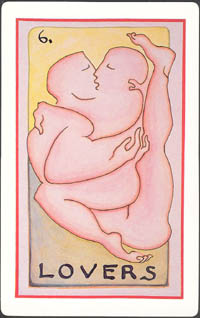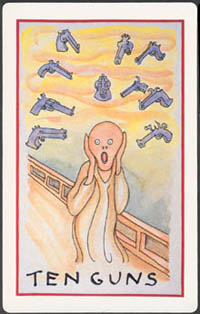|
 Brian William's postmodernistic PoMo Tarot is an excellent example of tarot as an art form. More
and more tarot packs will come to belong to this category. The Art Tarot is a tarot deck, which
is neither meant to be played with, nor to be used for divination, card reading or esoteric purposes.
For that use we have excellent traditional packs, like the Marseilles pattern, the Wirth and Crowley
decks and first and foremost the Waite-Smith pack. In Italy, artistic tarot decks, with no other
purpose than being a collection of art pieces - a small transportable art gallery, have long been
in vogue, and many an Italian artist have adopted the tarot structure as a framework for their
expressions. In the USA it is generally not so, almost all tarot decks manufactured are part of the
card reading craze. It is good to see, that we have here a dedicated art tarot from the American
artist, who earlier gave us the Renaissance Tarot.
Brian William's postmodernistic PoMo Tarot is an excellent example of tarot as an art form. More
and more tarot packs will come to belong to this category. The Art Tarot is a tarot deck, which
is neither meant to be played with, nor to be used for divination, card reading or esoteric purposes.
For that use we have excellent traditional packs, like the Marseilles pattern, the Wirth and Crowley
decks and first and foremost the Waite-Smith pack. In Italy, artistic tarot decks, with no other
purpose than being a collection of art pieces - a small transportable art gallery, have long been
in vogue, and many an Italian artist have adopted the tarot structure as a framework for their
expressions. In the USA it is generally not so, almost all tarot decks manufactured are part of the
card reading craze. It is good to see, that we have here a dedicated art tarot from the American
artist, who earlier gave us the Renaissance Tarot.
 Brian William's PoMo tarot is not solely an art tarot, it is also a paraphrase of the world's art and
it's peculiarities. In his minor arcana images, the observer can find references to famous pieces of
world art of the last 200 years, only here adjusted to William's manner. Should the onlooker not be
so well versed in art history, the the accompanying 120 page book offers an explanation, as well
as giving an explanation of the term "Postmodernism" itself (as far as such an explanation can ever be
given). How much we shall take William's words for fact is, however, quite another matter. On
page 4 in the book he claims, that C.G. Jung has analyzed the tarot for its universal, mythic
symbolism. No, Jung has not done so.
Brian William's PoMo tarot is not solely an art tarot, it is also a paraphrase of the world's art and
it's peculiarities. In his minor arcana images, the observer can find references to famous pieces of
world art of the last 200 years, only here adjusted to William's manner. Should the onlooker not be
so well versed in art history, the the accompanying 120 page book offers an explanation, as well
as giving an explanation of the term "Postmodernism" itself (as far as such an explanation can ever be
given). How much we shall take William's words for fact is, however, quite another matter. On
page 4 in the book he claims, that C.G. Jung has analyzed the tarot for its universal, mythic
symbolism. No, Jung has not done so.

The suits in William's deck are Guns, Bottles, TV-sets and Bills, a change that clearly depict the
world we live in, in which neither cups, swords nor staffs play any dominant role and where the forces
behind the coins or pentacles would better be represented by credit cards.
 The set is well-produced. The large size cards are well printed and the book is well designed in
a (post?) modernistic style. The cards come in a cardboard box, which together with the book is put
into a sturdy cassette. Something, however, went wrong here. The cardboard box and the book are
VERY difficult to get in and out of the cassette, which fits much too tight. My theory is, that
the cassette was constructed after the size of the deck (without the cardboard box). That's too bad
for an otherwise very well produced item.
The set is well-produced. The large size cards are well printed and the book is well designed in
a (post?) modernistic style. The cards come in a cardboard box, which together with the book is put
into a sturdy cassette. Something, however, went wrong here. The cardboard box and the book are
VERY difficult to get in and out of the cassette, which fits much too tight. My theory is, that
the cassette was constructed after the size of the deck (without the cardboard box). That's too bad
for an otherwise very well produced item.
|